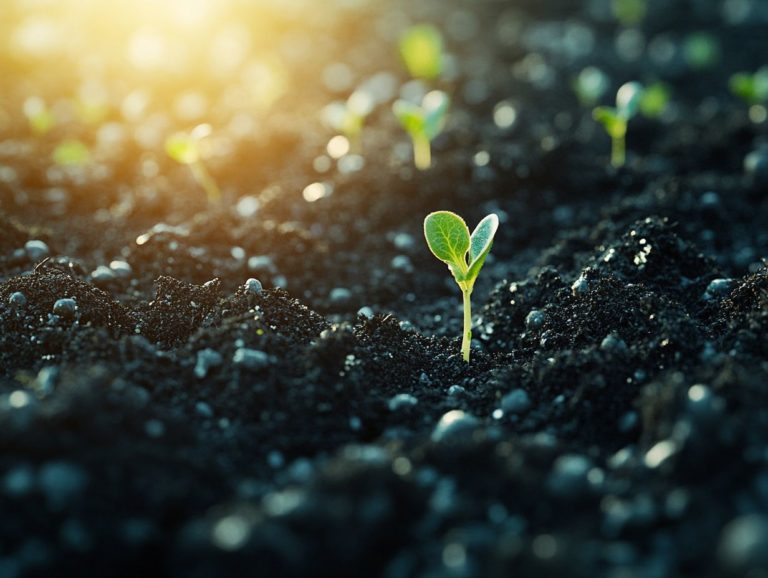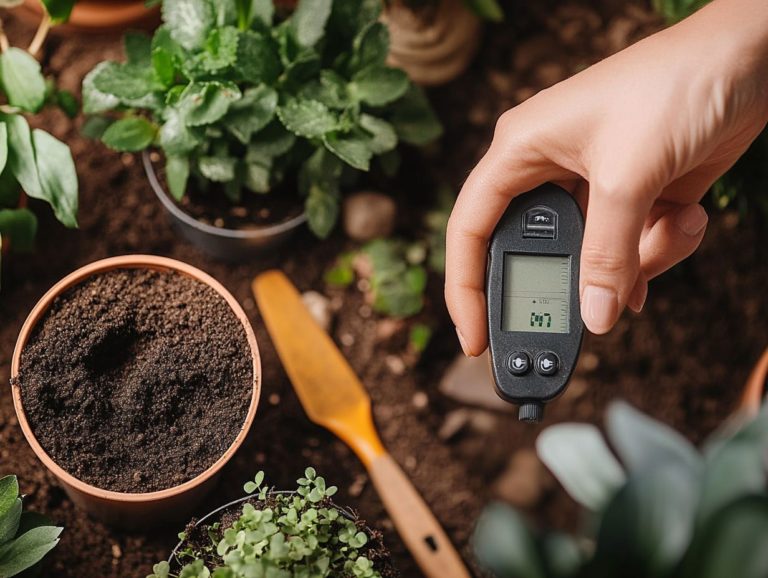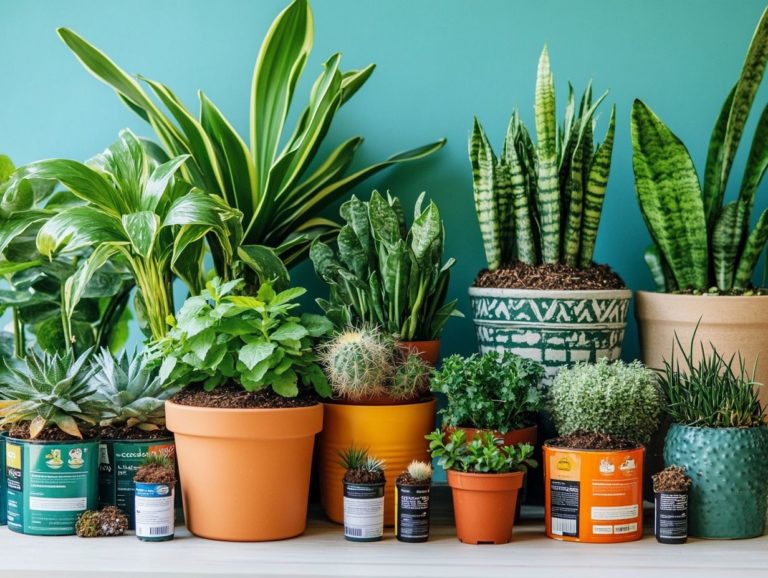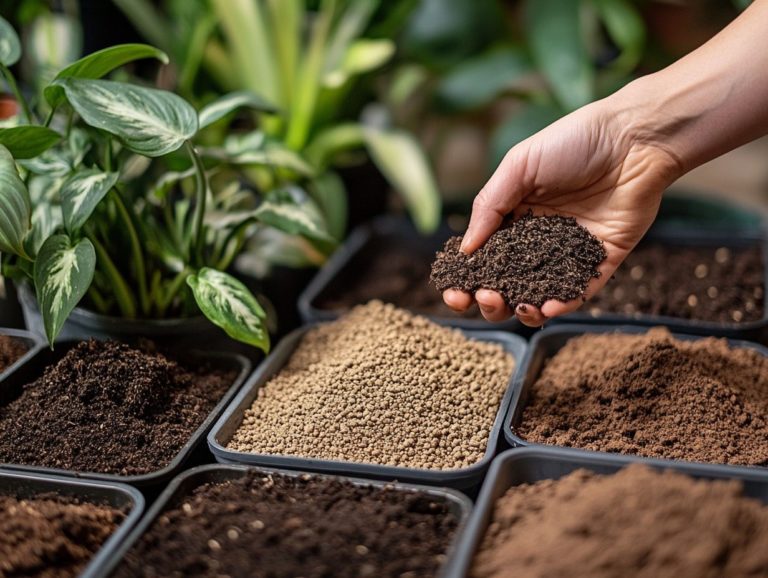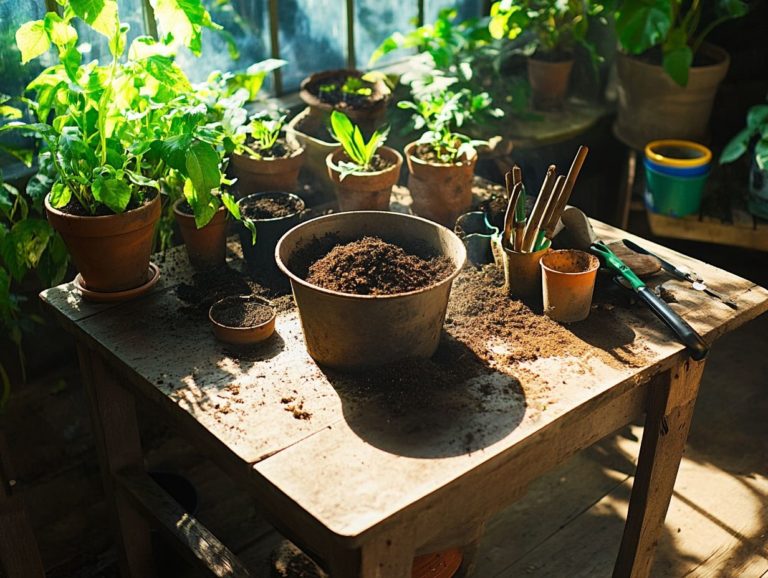Top 10 Houseplants That Prefer Sandy Soil
If you re seeking to introduce some low-maintenance greenery into your home, explore the amazing resilience and unique beauty of sandy soil-loving plants. Get ready to transform your home with these resilient plants!
Discover the top 10 houseplants that flourish in sandy soil, featuring beloved choices like cacti and aloe vera. This exploration will cover the benefits and challenges of nurturing these plants, offer insights on enhancing sandy soil, and highlight common pitfalls to steer clear of.
Prepare to cultivate your very own indoor oasis with these hardy houseplants!
Contents
- Key Takeaways:
- 1. Cacti
- 2. Succulents
- 3. Aloe Vera
- 4. Snake Plant
- 5. Ponytail Palm
- 6. Yucca
- 7. Agave
- 8. Hens and Chicks
- 9. Barrel Cactus
- 10. Desert Rose
- What Is Sandy Soil and Why Do These Plants Prefer It?
- Frequently Asked Questions
- 1. What are the top 10 houseplants that prefer sandy soil?
- 2. Why do these houseplants prefer sandy soil?
- 3. Can these houseplants survive in other types of soil?
- 4. How often should I water these houseplants in sandy soil?
- 5. Do these houseplants require any special care in sandy soil?
- 6. Can I use regular sand from my backyard as sandy soil for these houseplants?
Key Takeaways:
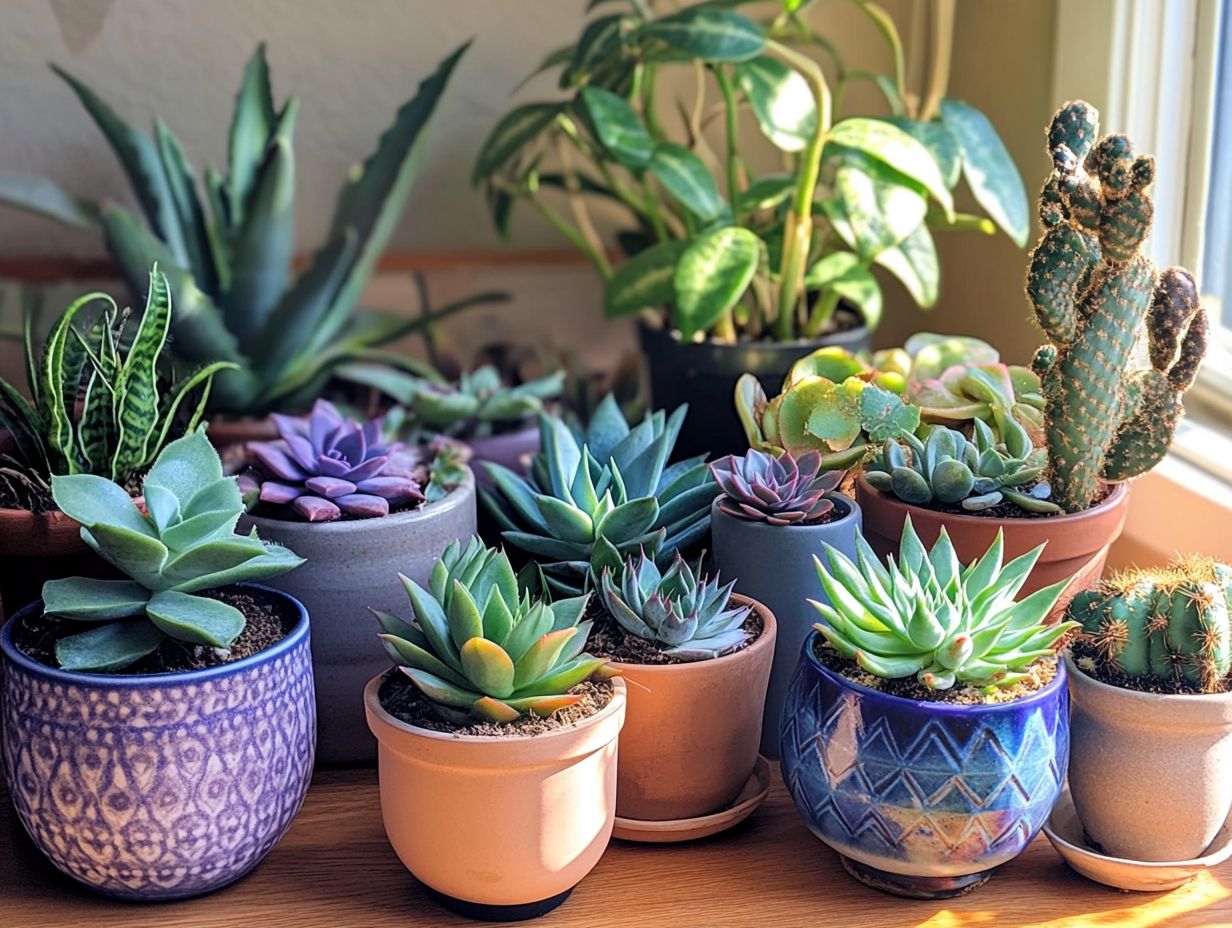
- Cacti and succulents are ideal for sandy soil due to their ability to store water.
- Sandy soil can promote better drainage and aeration for plant roots, leading to healthier growth.
- Proper preparation and maintenance, such as adding organic material, can improve sandy soil for optimal plant growth.
1. Cacti
Cacti are truly remarkable plants that excel in dry places, showcasing their extraordinary ability to adapt to sandy soil conditions. They require minimal watering, making them a top choice for landscape experts looking to create gardens that need little water and thrive under full sun exposure.
Take, for instance, the resilient Saguaro, celebrated for its impressive height and distinctive arm structure. The smaller yet striking Echinocereus is another great option. These plants have evolved to store moisture effectively, allowing them to withstand long periods without rain.
The popular Prickly Pear is a prime example; its flat pads serve not only as photosynthetic surfaces but also work to minimize water loss. These unique adaptations empower cacti to flourish in sandy, well-drained soils, promoting sustainable landscaping that demands less maintenance while delivering stunning visual appeal throughout the year.
2. Succulents
Succulents have certainly earned their place in your heart, thanks to their striking aesthetics and low-maintenance charm. They come in a delightful variety of forms and flourish in sandy soil that allows for excellent moisture retention, especially when enriched with organic material to boost growth.
These captivating plants offer an impressive array of shapes and colors. From the rosette formations of echeverias to the tall, columnar silhouettes of cacti, their beauty is undeniable. To provide them with the best care, ensure you position them in well-draining sandy substrates that allow excess water to escape, thus preventing root rot.
Their nutrient requirements are minimal, needing only occasional fertilization. Mindful water management is key to ensuring their longevity. When integrating them into your garden borders, think about layering different heights and colors to craft a visually engaging display. And don t forget their love for sunlight; maximizing their exposure will ensure those vibrant hues truly shine.
3. Aloe Vera
Aloe Vera is not just celebrated for its remarkable healing properties; it truly flourishes in sandy soil environments, requiring full sun to unlock its full potential. Adding organic material during its cultivation can significantly enhance its growth.
This versatile succulent serves a dual purpose, extending its reach beyond gardening. The rich gel extracted from Aloe Vera is a staple in medicinal applications, renowned for its ability to soothe sunburns, aid in wound healing, and deliver anti-inflammatory benefits.
Aloe Vera s natural hydrating qualities make it a sought-after ingredient in a myriad of beauty products. It enhances skin elasticity and promotes hair health.
For optimal growth, especially in sandy soils, it s crucial to water Aloe Vera sparingly and ensure proper drainage. This resilient plant truly thrives in dry conditions, so a little restraint goes a long way in nurturing its vitality.
4. Snake Plant
The Snake Plant, celebrated for its exceptional air purification abilities, is the perfect choice for you if you’re seeking a drought-tolerant plant that flourishes in sandy, well-drained soil with minimal maintenance.
Not only does it filter out toxins like formaldehyde and benzene, but it also converts carbon dioxide into oxygen at night. This significantly enhances the air quality of your indoor environment.
For optimal growth, place your Snake Plant in bright, indirect sunlight, which encourages vibrant development while shielding it from harsh afternoon rays.
It’s essential to keep the sandy soil somewhat dry between waterings. This resilient plant can fall victim to root rot if overwatered. By adhering to these straightforward guidelines, even novice gardeners like you can reap the aesthetic and health benefits that this hardy plant has to offer!
5. Ponytail Palm
The Ponytail Palm is a standout indoor plant that thrives in sandy soil, ensuring excellent drainage. If you’re seeking a drought-tolerant option that loves basking in the sun, this is your perfect match!
Its unique, swollen trunk not only stores water but also serves as a striking focal point in your indoor space. Typically growing between 3 to 10 feet, it showcases an elegant, cascading leaf structure that elevates the aesthetic of any room.
For optimal health, place it in a bright area with indirect sunlight, and remember to water it infrequently to prevent root rot.
With such low maintenance requirements, this resilient plant is perfect for busy lives easy to care for and stunning to look at!
6. Yucca

Yucca plants are an exceptional choice for your garden, especially if you’re aiming to create striking borders. They flourish in sandy soil while boasting impressive drought tolerance and a unique look that elevates your landscape design.
With various species available, such as Yucca filamentosa and Yucca elephantipes, you ll find different heights and leaf forms. This allows for versatile garden aesthetics that can be tailored to your vision.
Once established, these resilient plants require minimal watering, making them ideal for dry landscapes. Plus, their tall flower spikes are a magnet for butterflies and bees, enhancing the biodiversity of your outdoor space.
To further enrich your garden, consider companion planting with drought-resistant herbs like lavender or rosemary. These plants thrive alongside Yucca, attracting additional pollinators and beneficial insects. Together, they create a vibrant ecosystem that supports both your plants and local wildlife!
7. Agave
Agave plants stand out for their striking appearance and remarkable resilience. Thriving in well-drained sandy soil with full sun exposure, they require minimal care, making them a top choice for landscaping experts focused on drought-tolerant designs.
You ll find a plethora of Agave species, each bringing unique characteristics to enhance your landscape aesthetics. Take the Agave americana; its large rosettes and dramatic spines create an eye-catching focal point.
Then there s the Agave parryi, which features a compact form and blue-grey leaves that fit effortlessly into smaller gardens.
Caring for these hardy succulents is straightforward. They demand infrequent watering, further boosting their appeal for sustainable landscaping efforts.
By incorporating Agave into xeriscaping, or landscaping designed to reduce or eliminate the need for irrigation, you can create visually stunning environments that minimize water usage while promoting eco-friendly practices. Enjoy the natural beauty these plants offer!
8. Hens and Chicks
Hens and Chicks are delightful, low-maintenance plants. They thrive in sandy soil and retain moisture well.
These resilient succulents have a striking rosette shape. They thrive in well-drained conditions, perfect for sunny spots in your garden borders or in rock gardens.
Ideally, they bask in at least six hours of direct sunlight, allowing their vibrant colors to truly shine. By adding a layer of gravel or small stones around them, you can enhance drainage and protect their roots from excessive moisture.
Their remarkable adaptability makes them visually appealing. They are a practical choice for a stunning, low-maintenance landscape.
9. Barrel Cactus
The Barrel Cactus embodies resilience. It thrives in sandy soil and loves full sun.
This succulent comes in various varieties. Each showcases its unique allure.
- The Golden Barrel, adorned with striking yellow spines, creates a vibrant contrast against its rich green body.
- The California Barrel, notable for its impressive size, commands attention in any landscape.
Caring for these cacti is straightforward: just ensure proper drainage and provide occasional watering tailored to their specific needs.
When you creatively incorporate these cacti into desert-themed gardens, stunning displays result. Pair them with ornamental rocks or gravel pathways for added effect.
Using them as focal points in areas with little water can enhance beauty and highlight their hardy nature, making them the ideal choice for sustainable gardening.
10. Desert Rose
The Desert Rose is captivating with its vibrant blooms. It thrives in full sun and sandy soil.
To keep your Desert Rose looking its best, monitor your watering routine. Water it only when the top layer of soil feels dry, typically every two to three weeks.
Adding organic material enhances soil richness. It improves moisture retention and promotes blooming.
Plus, those striking flowers don t just catch the eye; they attract pollinators like butterflies, making your garden a visual delight and a crucial contributor to the local ecosystem.
What Is Sandy Soil and Why Do These Plants Prefer It?
Sandy soil has a coarse texture and excellent drainage. It creates the perfect setting for many plants to flourish.
This soil type encourages rapid water movement. It effectively prevents root rot and issues related to excess water.
Plants such as succulents, cacti, and certain perennials thrive in sandy conditions, as their root systems are designed to quickly absorb moisture during sporadic rain showers.
Sandy soil warms up faster in spring, fostering early growth. This gives gardeners a chance to extend their growing season.
With the right amendments, you can ensure that your chosen plants not only survive but truly thrive, showcasing vibrant health and resilience against environmental stressors.
What Are the Benefits of Growing Plants in Sandy Soil?
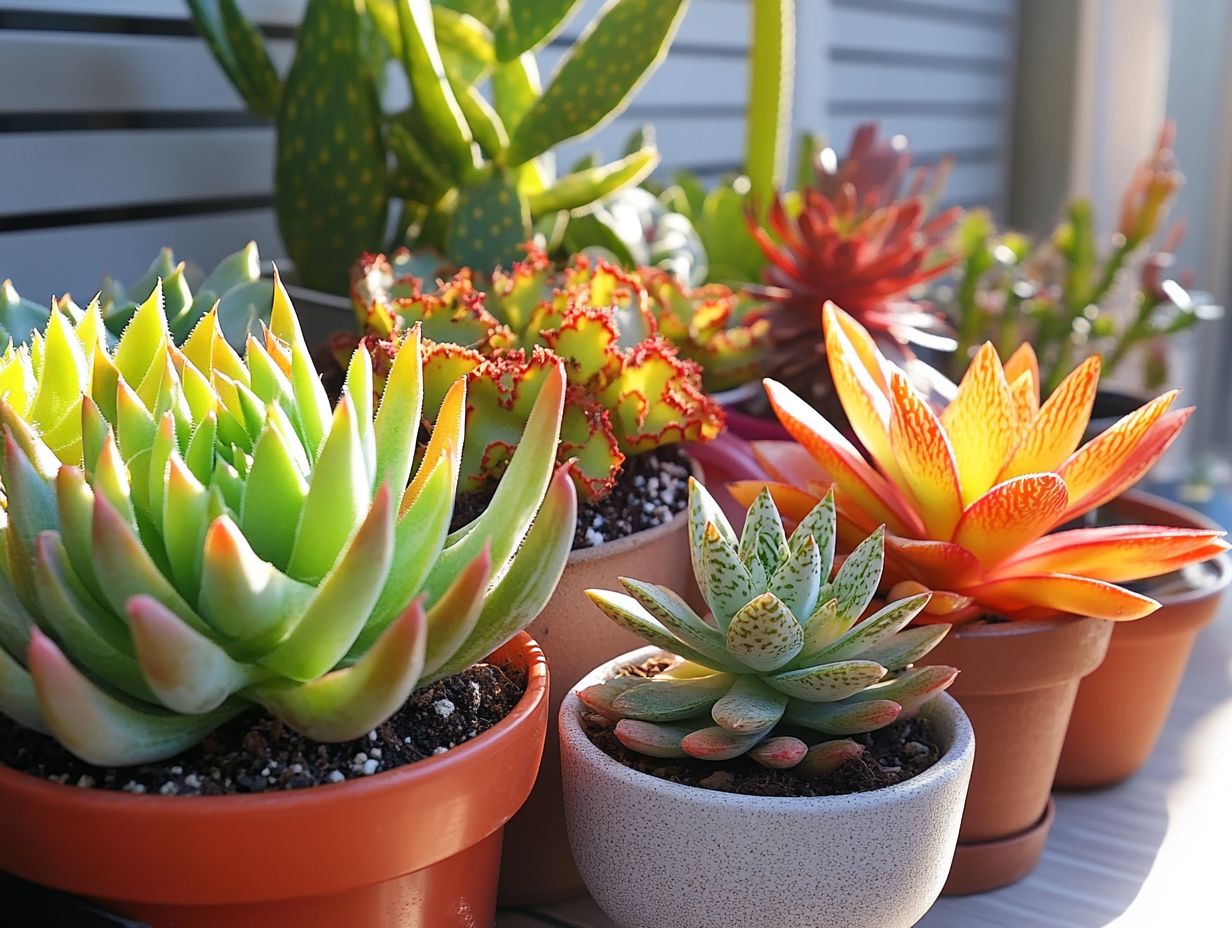
Growing plants in sandy soil offers a wealth of benefits, particularly its exceptional drainage capabilities. This feature is vital for drought-tolerant species that thrive in conditions where excess water swiftly evaporates.
This rapid drainage nurtures healthier root systems. With sandy soil, the risk of root rot an all-too-common challenge in heavier, moisture-retentive soils is significantly minimized. Its loose structure promotes superior aeration, allowing roots to breathe and access essential nutrients with ease.
Plants like succulents and cacti truly flourish in these conditions, relishing the dry environment that sandy soil offers. Even vegetables such as carrots and radishes appreciate this soil type, as it provides the ample space they need to develop without the constraints of compacted earth.
In essence, sandy soil cultivates a vibrant ecosystem for a diverse array of resilient plants.
What Are the Challenges of Growing Plants in Sandy Soil?
While sandy soil offers numerous benefits, it also presents challenges for you as a gardener. One major obstacle is holding nutrients and the need for a carefully tailored watering schedule to ensure your plants get the hydration and nutrients they require.
The rapid drainage can lead to nutrient deficiencies, which can hinder your plants growth and vitality. This happens when water drains away too quickly, whisking away valuable minerals along with it.
In hot weather, sandy soil dries out quickly, demanding vigilant water management on your part. To tackle these issues, consider incorporating organic amendments like compost to enhance nutrient retention and boost moisture levels.
Regular mulching can also work wonders by minimizing evaporation, creating a more stable environment for your plants. Understanding these tips can help you grow a thriving landscape despite the challenges that sandy soil presents.
How Can One Improve Sandy Soil for These Plants?
Improving sandy soil for plant growth requires you to incorporate organic material. This significantly enhances moisture retention and aids in nutrient binding, creating a more hospitable environment for plants that thrive in sandy conditions.
By integrating compost, you can dramatically boost your soil’s nutrient profile. This allows your plants to access essential elements more effectively. A layer of mulch acts as a protective blanket, reducing evaporation and preventing pesky weeds from competing for vital resources.
To take practical steps, mix well-rotted organic matter or leaf litter directly into the sandy soil. This promotes microbial activity, further breaking down nutrients to support your plants’ health.
Regularly updating these organic amendments will ensure your soil remains fertile and productive over time, fostering a thriving garden ecosystem.
What Are the Common Mistakes When Growing These Plants in Sandy Soil?
Common mistakes often stem from improper watering frequency and overlooking the specific nutrient requirements of your plants, which can hinder their growth and even lead to decline.
Many gardeners overlook that sandy soil drains quickly, resulting in under-watering or an erratic watering schedule. It’s crucial to frequently assess soil moisture instead of relying solely on a fixed watering routine.
Given that sandy soil typically lacks essential nutrients, incorporating compost or a balanced fertilizer can significantly enhance the health and vigor of your plants.
By closely observing how your plants respond and adjusting your care practices accordingly, you can cultivate an environment that meets the unique challenges posed by sandy soil. Consider incorporating top indoor plants for artificial light to enhance your space. Act now to improve your sandy soil and yield more vibrant and resilient plants!
What Are Some Other Plants That Can Thrive in Sandy Soil?
Along with the highlighted varieties, you’ll find that many other plants thrive in sandy soil. Consider drought-tolerant options like Black-eyed Susan, Lavender, and Zinnia. These beautiful plants thrive effortlessly and attract beneficial pollinators like butterflies, turning your garden into a lively hub.
Think about adding ornamental grasses such as Blue Fescue and Switchgrass. They also add texture to your landscape and provide shelter for small animals, creating a harmonious environment.
The vibrant blooms of Coneflower and Coreopsis will infuse your garden with lively colors while enticing bees and hummingbirds to visit.
If you’re looking for greenery that requires minimal care, hardy Sedum varieties and native Penstemon are excellent choices. They can withstand harsh, dry conditions while enhancing the aesthetic appeal of any garden.
Each of these selections brings unique qualities that contribute to a healthier ecosystem and a visually stunning outdoor space, making your gardening experience amazing.
This video offers tips on choosing the best plants for sandy soil, ensuring your garden flourishes.
Frequently Asked Questions
Here are some common questions about houseplants that prefer sandy soil.
1. What are the top 10 houseplants that prefer sandy soil?
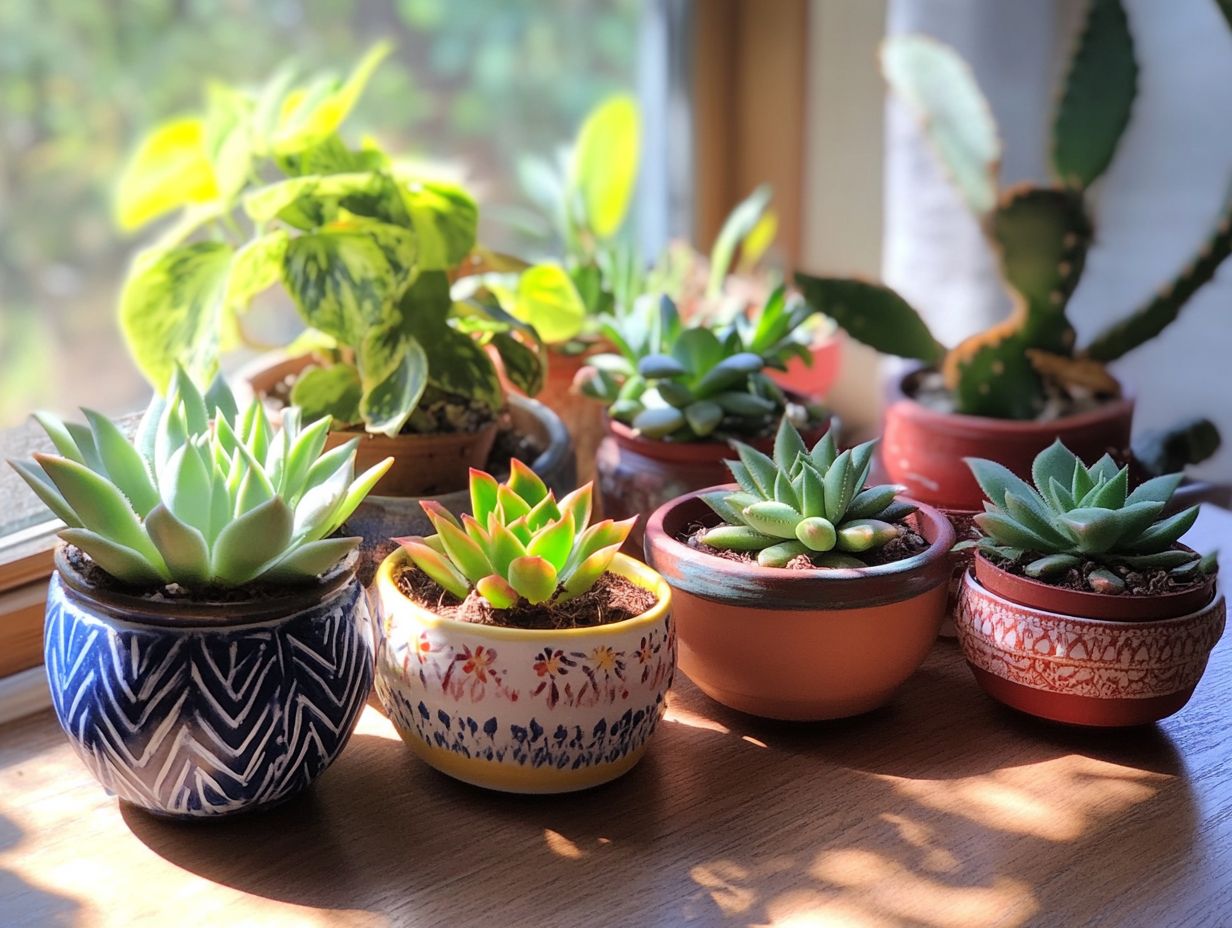
The top 10 houseplants that prefer sandy soil include cacti, succulents, aloe vera, spider plant, yucca, ponytail palm, snake plant, jade plant, peace lily, and rubber plant.
2. Why do these houseplants prefer sandy soil?
These houseplants prefer sandy soil because it provides good drainage, which prevents overwatering and root rot. Sandy soil also allows for better aeration, the process of allowing air to reach the roots, which helps the roots thrive.
3. Can these houseplants survive in other types of soil?
While these houseplants prefer sandy soil, they can still survive in other types of soil as long as it is well-draining and allows for proper aeration. However, they may not grow as well or be as healthy in non-sandy soil.
4. How often should I water these houseplants in sandy soil?
The watering frequency for these houseplants in sandy soil will depend on various factors such as the type of plant, its size, and the climate. Generally, these plants should be watered when the top inch of soil is dry.
5. Do these houseplants require any special care in sandy soil?
Aside from proper watering, these houseplants do not require any special care in sandy soil. Just make sure to fertilize them regularly and provide enough sunlight, and they should thrive.
6. Can I use regular sand from my backyard as sandy soil for these houseplants?
No, regular sand from your backyard may not be suitable for these houseplants. It may contain harmful substances or be too dense, which can harm their roots. It is best to use commercially available sandy soil mix for these houseplants.
Don t wait! Transform your garden with these stunning plants today! Explore your local nursery to find these fantastic plants!

